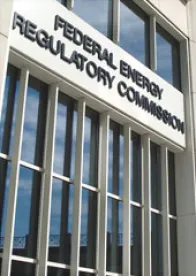On Thursday, March 21, 2019, the Federal Energy Regulatory Commission (“FERC” or “Commission”) issued two Notices of Inquiry (“NOIs”). One NOI focuses on FERC’s approach to determining the Return on Equity (“ROE”) for FERC jurisdictional electric transmission and cost-based wholesale power rates (“ROE Inquiry”) [b],[1] and the second NOI focuses on the Commission’s transmission incentives policies (“Incentives Inquiry”)].[2] The NOIs are referred to collectively in this write-up as the “Transmission NOIs.”
Interestingly, we wanted to note up front that the ROE Inquiry proceeding is relevant to owners of, investors in, and shippers on FERC-jurisdictional natural gas pipelines and oil pipelines because, among other things, FERC seeks comment on whether its ROE policies should apply to FERC jurisdictional rates for natural gas pipeline and oil pipelines in addition to FERC jurisdictional cost-based rates for electric transmission and wholesale power. The FERC approach to setting ROEs for natural gas pipelines and electric transmission has more recently converged and the ROE Inquiry recognizes that expressly and asks for input from the industry and others.
FERC identifies the following eight “general topics” as the focus of its questions in the ROE Inquiry:
-
Role of the base ROE investment decision-making and what objectives should guide FERC’s approach;
-
Whether uniform application of base ROE policy across electric, interstate natural gas pipeline and oil pipeline industries is appropriate and advisable;
-
Performance of the Discounted Cash Flow (“DCF”) model (the model FERC has relied on for both natural gas pipeline and electric transmission rate cases involving ROE determinations);
-
Proxy groups (for purposes of inputs to financial models);
-
Financial model choice;
-
Mismatch between market-based ROE determinations and book-value rate base;
-
How to determine whether an existing ROE is unjust and unreasonable pursuant to the first prong of Section 206 (a very specific application of Federal Power Act (“FPA”) provisions); and
-
Financial model mechanics and implementation.
The Incentives Inquiry is intended to gather information so that FERC may more closely examine and possibly update FERC’s policies on electric transmission incentives.
-
FERC seeks comments on what its electric transmission incentives policies should seek to incent, including whether its determinations on eligibility for transmission incentives should focus on the risk and challenges of transmission projects or on what benefits the project could provide, including reliability and economic impact.
-
FERC also seeks input on the use of transmission incentives to respond to grid “issues” that have become increasingly important since it last revisited its transmission incentive policies on a generic basis in 2012 such as:
-
flexible transmission operation (i.e., increased line rating precision, greater power flow control, and technologies such as energy storage) to respond to changes in generation mix;
-
enhancing physical and cyber-security of existing transmission facilities;
-
resilience (i.e., ability to withstand and reduce the magnitude and/or duration of disruptive events); and
-
incremental improvements to existing transmission facilities to incorporate advanced management software or application of technologies such as energy storage in order to improve the use of the existing transmission system.
-
-
The Incentives Inquiry asks for comment on how best to unlock locationally constrained generation resources.
-
The Incentives Inquiry seeks comment on what additional steps FERC could take through the incentives process, if any, to promote interregional transmission projects (i.e., could transmission incentives assist with the FERC’s Order No. 1000 efforts considering that interregional transmission facilities “have been scarce to date”).
-
FERC is also reconsidering its incentives for transmission-only companies, including what occurs when a transmission-only company becomes affiliated with a market participant subsequent to FERC’s grant of a “Transco” incentive.
-
FERC is also reconsidering its 50 basis point “adder” policies for Independent System Operator (“ISO”)/Regional Transmission Organization (“RTO”) (collectively, “ISO”) participation in light of a recent Ninth Circuit decision[3] that raised issues regarding such incentives.
Frequently Asked Questions
In response to significant interest in the Transmission NOIs and the substance of the inquiries we received, we provide a response to frequently asked questions below in short answer format. We note that the Transmission NOIs are not lengthy but are very substantive. So, unlike some other government agency issuances, the best way to become familiar with the issues raised in these particular proceedings may be to review them.
Q: What is the timing of FERC response following submissions responding to the Transmission NOIs?
A: FERC is under no deadline to respond to comments submitted in the Transmission NOI proceedings. These proceedings are information “collection” efforts and the scope of the issues FERC seeks input on vary widely. Some issues are very targeted while others are far broader. FERC could follow up with a technical conference or issue a Notice of Proposed Rulemaking or a Policy Statement. Also, FERC could simply use the material submitted in the proceedings as guidance to rely on in future company-specific proceedings and take no further action on a generic basis.
Q: How might the Transmission NOIs effect ongoing proceedings?
A: As noted above, this is an information gathering exercise for FERC and the Commission is not required to act in response to comments within any set time-frame and, in fact, it may choose not to take any further action on these items in these generic proceedings. Nothing in the Transmission NOIs indicates that they stay or otherwise interfere with pending cases. After the FERC meeting, in a press conference, Chairman Neil Chatterjee noted on an informal basis that pending cases would move forward without delay associated with the Transmission NOIs. In statements made at the meeting, Commissioner Cheryl LaFleur noted that currently pending electric transmission rate cases involving ROE determinations will provide the Commission with information regarding transmission ROE methodologies but said nothing more about the interplay between the company-specific proceedings currently pending before FERC and the Transmission NOIs (generic proceedings).
Q: Reading these inquiries, we realize that the scope of information FERC seeks is very broad. Could we submit limited and targeted comments rather than try to respond to many of the issues presented?
A: FERC is looking for “focused and concise” comments. In comments at the related FERC meeting, Commissioner Cheryl LaFleur noted that in light of the breadth of the topics covered in the Transmission NOIs, FERC is allowing 90 days for comment but that commenters need not respond to every question.
Transmission ROE Inquiry
Q: Should I be focused on the ROE Inquiry?
A: We anticipate that electric transmission owners and customers will consider responding to Transmission NOIs, either on their own and/or with a group, because the issues are “in their alley.” We suggest that interested parties take the time to review the two Transmission NOIs – they are very substantive and although not lengthy, cover many topics. In this case, a quick read is valuable.
Also, and interestingly, FERC seeks input from entities with interests in natural gas pipeline and oil pipeline rates and from investors in utility equities. As mentioned above, among other things, the ROE Inquiry asks whether electric transmission ROE policies should be extended to FERC jurisdictional rates in the natural gas pipeline and oil pipeline context.
FERC is also seeking feedback from the investor community on what investors look at when deciding on investments in utilities. In its ROE Inquiry proceeding, FERC seeks input on what financial models investors use in addition to the DCF model “to evaluate utility equities” and the “strengths and weaknesses of each of those models.” Investors in utility equities are infrequent participants in FERC proceedings so it will be interesting to see if they participate in the ROE Inquiry in response to FERC’s specific request. Investors in utility equities commented in cases related to FERC’s implementation of the Energy Policy Act of 2005 in the 2005-2008 time-period but are not otherwise frequently active in FERC proceedings. As an alternative to submitting formal public comments, investors in utility equities could consider visiting with FERC Staff or FERC Commissioners to discuss the issues more informally.
Q: FERC seeks comments about whether to implement consistent ROE policies for electric transmission, natural gas pipelines, and oil pipelines. In the past, FERC took differing approaches to ROE based on the infrastructure at issue. What changed?
A: In the past several years, FERC’s application of the DCF methodology to natural gas pipeline and electric transmission rates converged. In FERC’s Opinion No. 531 involving the New England Transmission Owners,[4] FERC implemented a two-step DCF model (long applied by FERC in the natural gas pipeline context) rather than continuing to apply a one-step DCF model that it had applied for electric transmission over recent years. The D.C. Circuit vacated Opinion No. 531.[5] However, in response, FERC proposed a two-step DCF analysis as part of a proposed methodology to determine ROEs[6] rather than reverting to the “one-step” used for electric transmission in past years.
That being said, there are distinguishing features between most natural gas pipeline rates and most electric transmission rates. While FERC rates for electric transmission frequently rely on formula rates where the ROE is an isolated input, many FERC natural gas pipeline rates remain fixed stated rates resulting from settlements so it is not clear what the current ROE is as a single component to the rate. FERC Staff noted that distinction during the March 21, 2019 Commission meeting:[7] “unlike electric utilities most of whom feature formula rates with explicit ROEs . . . pipeline rates are set by [fixed stated] rate cases” and those cases “usually settle with black box revenue requirements without stated ROEs.”
Q: In October of 2018, FERC proposed an analysis to determine electric transmission ROEs but in this case it seems to be considering some of the same issues. Could you discuss that?
A: FERC is looking for further information on the models it proposed to determine transmission ROE in the Briefing Order. For example, FERC seeks input on the “robustness of the DCF model over time and under differing conditions.” FERC also asks for comments on the appropriate guidelines for proxy group composition, elimination of outliers and placement of base ROE within a zone of reasonableness.
Also, FERC seeks comment on “the mismatch between market-base ROE determinations and book value rate base and whether this mismatch is a problem. . . .” In addition, FERC seeks comment on the mechanics and implementation of the four models it proposed to use in the Briefing Order: (1) DCF, (2) Capital Asset Pricing Model, (3) Expected Earnings and (4) Risk Premium. FERC seeks input regarding underlying data and mechanics specific to each of the four models. It appears that FERC is planning to consider these issues in a generic proceeding concurrently with company-specific proceedings. As noted above, FERC is under no obligation to take any steps on a generic basis as a result of initiative the Transmission NOIs.
Q: What entirely new ROE proposals does FERC propose in the ROE Inquiry?
A: FERC makes “new” inquiries that reflect a departure from how FERC’s issuances have indicated it considers ROE issues in the past. For example, FERC seeks comment on whether the cost of capital at the time of an investment should “set” the ROE for the life of the project investment such as through the use of a “vintage approach.” Alternatively, FERC inquires whether a project ROE should be subject to “automatic” adjustment to reflect the contemporary ROE required by the assets. FERC also seeks comment on whether the Commission should consider applying the same ROE to all utilities in centralized ISOs based on the most recent proceeding for a company with jurisdictional assets in that ISO. If implemented, these approaches would be a substantial departure from FERC precedent and may create uncertainties.
Transmission Incentives Inquiry
Q: What transmission incentives issues are FERC “revisiting” in this proceeding?
A: FERC implemented transmission incentive directives shortly after the Energy Policy Act of 2005. Certain of FERC’s questions in the Incentives Inquiry go to whether its determinations on granting incentives should focus on incenting projects with risks and challenges or focus on reliability and economic benefits resulting from reductions in the cost of delivered power (for example, due to reduced transmission congestion a transmission project may provide). Commissioner Richard Glick in comments at the March 21 FERC meeting regarding the Incentives Inquiry indicated that the Commission seeks assurances that the incentives it grants “are incenting or whether the investments would occur anyway, in other words, we should not be handing out the FERC candy without receiving something beneficial in return.” In the Incentives Inquiry, FERC asks, for example, how it might weigh benefits relative to costs when evaluating a request for incentives. FERC also seeks comment on whether it should condition incentives on the proponent meeting benefit-to-cost benchmarks. FERC also asks for comments on whether it could use certain transmission project characteristics as a proxy for expected benefits.
Q: If FERC decided to consider project characteristics as a proxy for expected benefits when granting transmission incentives, what are the types of project characteristics that the Incentives Inquiry suggest could be considered?
A: The Incentives Inquiry asks whether project characteristics such as “location in regions with persistent needs, interregional transmission projects or transmission projects that unlock constrained resources” could be used for this purpose and also asked commenters to identify drawbacks to this approach.
Q: FERC seeks comment on how incentives could be tailored to meet incentive objectives in the Incentives Inquiry. What objectives did FERC identify and were any objectives tied to the challenges the industry faces related to the changing mix of generation and other issues that have arisen since FERC first implemented the Energy Policy Act of 2005’s transmission incentive directives?
A: In the Incentives Inquiry, FERC identified reliability benefits, economic efficiency benefits, persistent geographic needs, flexible transmission system operation, security, and resilience as incentive objectives. As to flexible transmission system operation, FERC seeks comment on whether these criteria should benefit from transmission incentives and noted that the requirements of the transmission system are changing as the generation mix changes. “Flexibility characteristics of the transmission system, such as increased line rating precision, greater power flow control, and technologies, including energy storage, may be able to facilitate the transmission system’s ability to respond to changing circumstances.”
FERC also seeks comment on the benefits of enhanced physical and cyber-security of existing transmission facilities and the relation to transmission incentives.
FERC also focuses on the possibilities that transmission incentives could be available for investments related to: resilience (i.e., ability to withstand and reduce the magnitude and/or duration of disruptive events); and improving existing transmission facilities with incremental improvements to incorporate advanced management software or application of technologies such as energy storage in order to improve the use of the existing transmission system. The Incentives Inquiry also focuses on and seeks comments on how best to unlock locationally constrained generation resources. In comments at the meeting, Commissioner Richard Glick noted that the Transmission NOIs reflect that the Commission wants investment in “transmission and greater reliability, reduced congestion and access to less expensive generation and remotely located resources” but that on the other hand FERC has the responsibility to ensure that rates are just and reasonable.
Q: Does the FERC Incentives Inquiry propose to eliminate existing transmission incentives?
A: The Incentives Inquiry does seek comment on FERC’s independent transmission company adder and separately, on its ISO participation adder. As you are aware, these incentives have come under scrutiny recently in FERC proceedings[8] and in a Ninth Circuit decision.[9] FERC asks for comment on its continued application of these incentives.
Q: How does FERC consider the Incentives Inquiry to be related to FERC Order No. 1000?
A: FERC asks for comments on how its incentives policy might promote the goals of Order No. 1000. For example, and as mentioned above, FERC is seeking comment on how its incentives policies could help to incent investment in interregional transmission projects.
[1] Inquiry Regarding the Commission’s Policy for Determining Return on Equity, 166 FERC ¶ 61,207 (2019).
[2] Inquiry Regarding the Commission’s Electric Transmission Incentives Policy, 166 FERC ¶ 61,208 (2019).
[3] Cal. Pub. Utils. Comm’n v. FERC, 879 F.3d 966 (9th Cir. 2018).
[4] Coakley, Mass. Attorney Gen. v. Bangor Hydro-Elec. Co., Opinion No. 531, 147 FERC ¶ 61,234, order on paper hearing, Opinion No. 531-A, 149 FERC ¶ 61,032 (2014), order on reh’g, Opinion No. 531-B, 150 FERC ¶ 61,165 (2015).
[5] Emera Me. v. FERC, 854 F.3d 9 (D.C. Cir. 2017).
[6] Coakley v. Bangor Hydro-Elec. Co., 165 FERC ¶ 61,030 (2018).
[7] Meeting video available.
[8] Pac. Gas and Elec. Co., 164 FERC ¶ 61,121 (2018); Consumers Energy Co. v. Int’l Transmission Co., 165 FERC ¶ 61,021 (2018).
[9] Cal. Pub. Utils. Comm’n v. FERC, 879 F.3d 966 (9th Cir. 2018).





 />i
/>i

